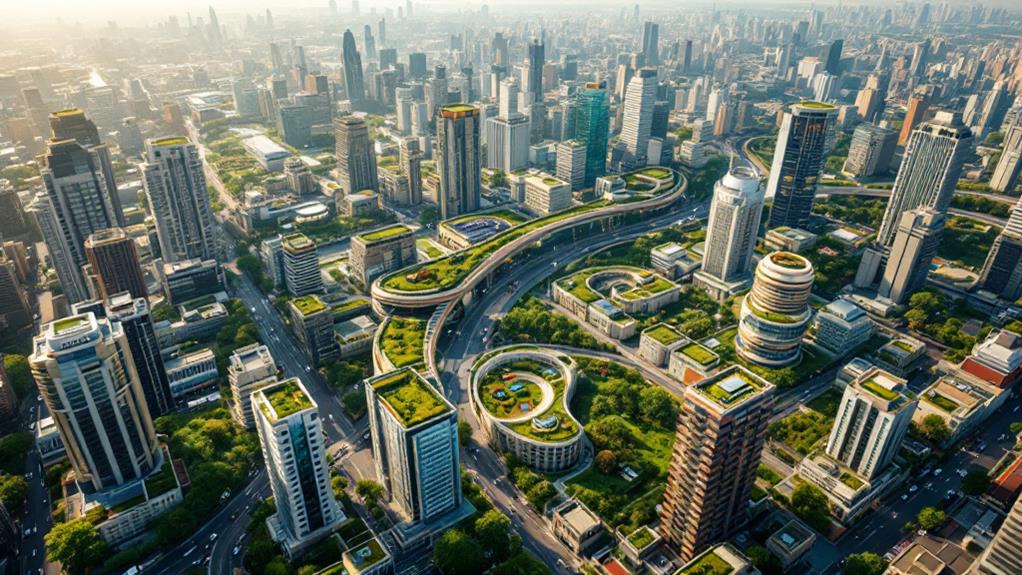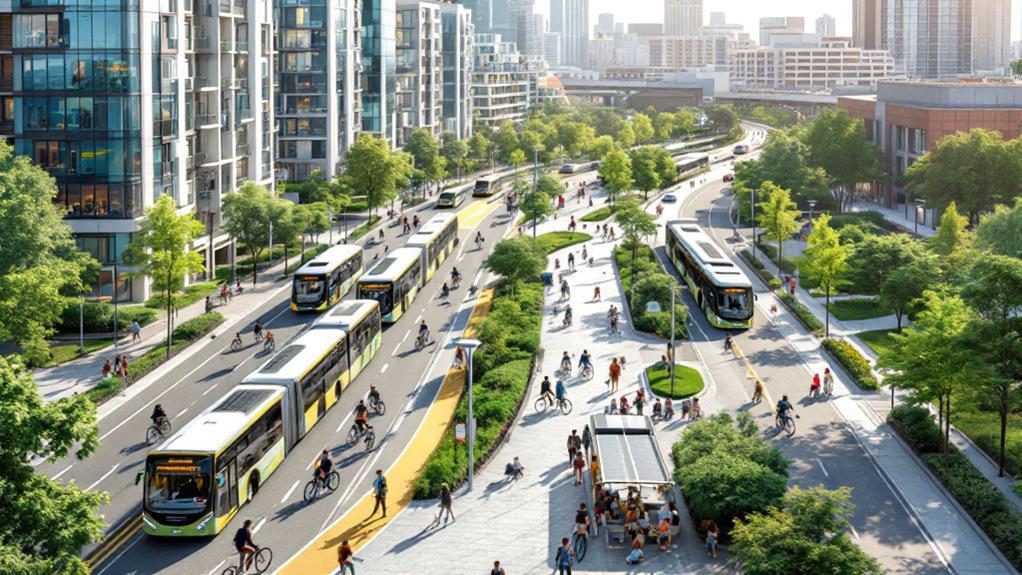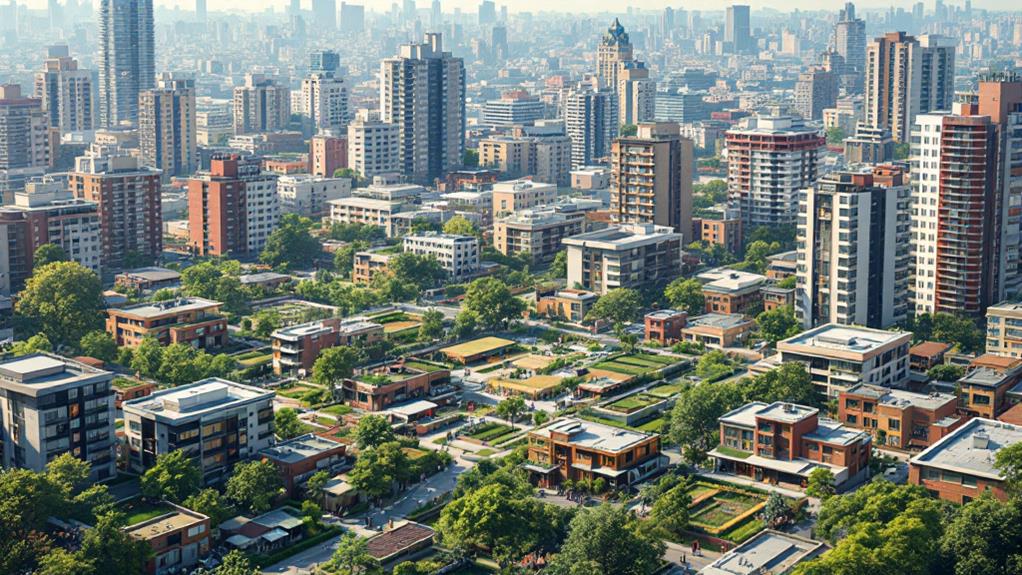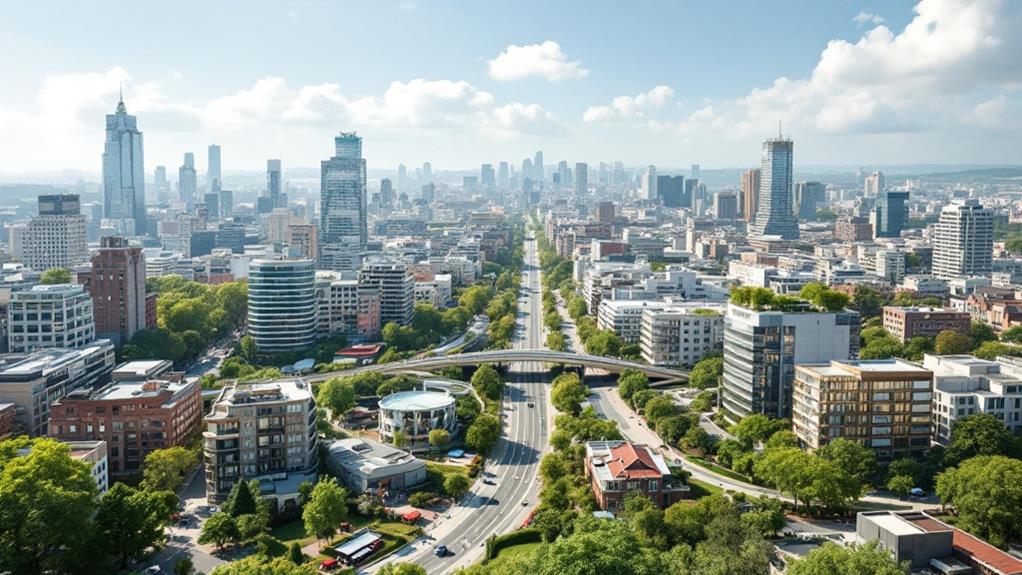How the Largest Urban Areas Are Managing Population Growth

You'll find the largest urban areas managing population growth efficiently through creative strategies. They're utilizing smart city technologies to optimize resources and densifying cities to curb sprawl. Enhancing public transportation reduces congestion and emissions, while green infrastructure like parks improves urban livability. Affordable housing policies and inclusionary zoning are addressing shelter needs for diverse populations. Urban planners are focusing on sustainability by integrating ecological preservation with development. Strong governance guarantees effective service delivery and resilience against climate change. These extensive strategies help cities balance growth and quality of life, offering more insights into successful urban management.
Urban Planning Innovations
As cities face rapid population growth, urban planning advancements are fundamental to maintaining livability and functionality. You're witnessing a transformative period where smart city technologies play an imperative role in optimizing resource management and enhancing urban services. By integrating data analytics and IoT, cities can meaningfully improve life quality, making them more efficient and sustainable.
Densification strategies, like those in Tokyo, show that increasing building heights and supporting mixed-use developments can effectively reduce urban sprawl. These strategies maintain lively communities without sacrificing space, promoting environmental sustainability. In Vancouver, groundbreaking zoning regulations encourage affordable housing and mixed-use neighborhoods, ensuring inclusivity and accessibility for all residents.
Green infrastructure is another critical component of urban planning. Singapore exemplifies this by incorporating parks and green roofs, mitigating the urban heat island effect and fostering environmental sustainability. Public transportation is prioritized in cities like Bogotá, where a successful bus rapid transit system minimizes congestion and improves air quality.
Through these advancements, urban planning not only addresses population growth challenges but also creates a more connected and sustainable future for city dwellers. Embracing these innovations is key to thriving in an ever-expanding urban landscape.
Infrastructure Development Strategies
Urban planning innovations lay the groundwork for addressing rapid population growth, but they're only part of the solution. To effectively manage urban expansion, infrastructure development strategies must be robust and forward-thinking. With the World Bank investing around $5 billion annually in urban infrastructure projects, cities are focusing on enhancing their planning systems to accommodate growing populations. It's essential to strategically align land use and zoning regulations, as these measures directly impact the availability of housing and services.
Urban areas are consuming land at a rate 50% faster than their populations are growing. This trend demands thorough municipal planning to prevent unplanned sprawl and overcrowding. Effective zoning can help direct growth where infrastructure supports it, guaranteeing that urban expansion remains sustainable. By integrating ecological asset protection with infrastructure plans, cities can balance development with environmental preservation.
Municipal planning capacity is your ally in preparing for the future. Inclusive land use strategies should consider a 30-year horizon, helping urban areas predict and meet their infrastructure needs. By doing so, you can avoid the pitfalls of unplanned urban growth and guarantee that cities remain livable and efficient as populations rise.
Sustainable Transportation Solutions

Transportation innovation is at the heart of building sustainable urban futures. With urban population growth escalating, sustainable transportation solutions become fundamental in managing this surge. Urban areas contribute over 80% of global GDP, so maintaining economic growth while reducing congestion and pollution is vital. By adopting low-carbon transport strategies, cities can considerably cut greenhouse gas emissions, which currently account for about 20.4% of global CO2 emissions.
Public transport systems play an essential role in providing access to urban services. They connect residents to health, education, and job opportunities, especially benefiting low-income individuals. Investing in electric buses and trams not only improves air quality but also aligns with climate resilience goals by reducing reliance on fossil fuels.
Sustainable transportation initiatives like bike-sharing programs and pedestrian-friendly infrastructure help minimize urban land consumption and lower greenhouse gas emissions. These efforts elevate the livability of cities while supporting economic growth. By prioritizing these green strategies, cities can create a more sustainable future, ensuring that urban areas remain dynamic and accessible for everyone. As you navigate these urban environments, consider how these initiatives impact your daily life and contribute to a healthier planet.
Green Spaces and Livability
Green spaces are fundamental for enhancing the livability of densely populated urban areas. As cities expand, urban planning must prioritize these critical areas to manage urban growth effectively. Public parks and green spaces not only beautify neighborhoods but also play an essential role in improving air quality and reducing urban heat island effects. This makes them indispensable for sustainable development, providing a healthier environment and promoting physical activity. When you have easy access to urban green spaces, you're more likely to engage in outdoor activities, which can notably lower rates of physical inactivity—a major global health concern.
Investing in green spaces can also stimulate economic growth. When cities prioritize well-maintained public parks, property values often rise, attracting more residents and businesses. This economic enhancement supports community resilience, making neighborhoods more robust in the face of challenges like climate change and other environmental hazards. Thoughtful urban planning that includes green spaces isn't just about aesthetics; it's about creating livable, sustainable communities that thrive amidst urban growth. So, when cities emphasize the development and maintenance of these areas, they're investing in a future where both residents and the environment can flourish together.
Affordable Housing Policies

As population growth continues to surge in urban areas, the need for affordable housing policies has become more pressing than ever. You're seeing cities tackle this issue with diverse strategies to guarantee everyone has a place to call home. Major urban areas are focusing on inclusionary zoning, which requires new residential projects to include a portion of affordable units. This approach directly addresses urban poverty by integrating low-income housing into market-rate developments.
Consider these key actions:
- Inclusionary Zoning: Guarantees a percentage of new developments are affordable.
- Rent Control: Cities like New York and San Francisco stabilize housing costs in rapidly gentrifying neighborhoods.
- Public-Private Partnerships: Toronto and London utilize these to fund affordable housing projects.
- Global Housing Strategy: Aims for at least 30% of new housing to be affordable by 2030.
- Policy Interventions for Informal Settlements: Nearly 1 billion urban poor live here, highlighting the need for improved living conditions.
Public-private partnerships are essential in funding these housing projects, especially in rapidly growing cities. The Global Housing Strategy pushes for policy interventions that help meet the housing needs of urban areas. Addressing these challenges will require creative solutions and commitment from all stakeholders.
Social Inclusivity Measures
Fostering social inclusivity in urban areas involves creating environments where everyone, especially marginalized communities, can thrive. Many large urban areas are now implementing inclusive urban policies to guarantee equitable access to housing and vital services. This is fundamental for addressing the needs of nearly 1 billion urban poor living in informal settlements globally. By prioritizing low-income urban communities in development efforts, cities aim to generate job opportunities and improve access to vital services, fostering economic growth in underserved regions.
Urban planning initiatives emphasize community engagement, assuring that the voices of the most vulnerable populations are considered in decision-making processes. This approach strengthens resilience against economic and environmental shocks. Integrated strategies that combine planning, land access, infrastructure, and financing are vital for addressing social inequalities. These strategies promote inclusivity in rapidly growing urban settings.
Moreover, gender inclusion and disability considerations are prioritized in urban development projects. This focus aims to create accessible urban environments, guaranteeing that all community members can fully participate in social, economic, and civic life. By incorporating such measures, cities can build a more inclusive future, where marginalized communities aren't left behind, and everyone has a chance to succeed.
Governance and Resilience

Building upon the foundation of social inclusivity measures, effective governance plays an essential role in managing urban population growth. Cities with strong institutions can efficiently deliver municipal services, attracting private capital investments and promoting economic growth. Particularly in high-income countries, effective governance improves the impact of economic growth on urban land expansion (ULE). This serves as an example of how governance quality notably influences urban development.
In developing countries, where the majority of urban population growth occurs, effective governance is critical to mitigate challenges like informal settlements and inadequate infrastructure. Here's how effective governance and urban resilience strategies make a difference:
- Guarantees sustainable urban development by integrating planning with economic growth.
- Facilitates urban resilience against climate change effects, protecting communities.
- Mediates economic growth and ULE to adapt cities to growing populations.
- Promotes efficient infrastructure development, improving citizens' quality of life.
- Supports policy frameworks that foster ULE in a controlled, sustainable manner.
Implementing urban resilience strategies backed by robust governance helps cities address climate change challenges. By focusing on sustainable urban development, these strategies guarantee that rapidly growing megacities can adapt and thrive, securing a resilient future for their citizens.
Future Urban Growth Projections
The future of urban growth presents both challenges and opportunities as the global urban population is set to rise by 2.5 billion by 2050. With 90% of this growth happening in less developed countries, urban areas will face immense pressure on infrastructure and services. You must focus on densification and expansion strategies to accommodate an extra 1.5 billion people. This means you'll need to be proactive in urban planning to guarantee your cities can handle these influxes effectively.
Notably, 70% of this urban growth will concentrate in just 20 countries, making targeted planning fundamental. By addressing land use, you can prevent urban sprawl and promote sustainable development. Urban land consumption is projected to exceed population growth by 50%, so creative strategies are indispensable. You'll need to balance economic development with environmental sustainability, making sure that cities remain livable and resilient.
Effective governance plays a key role in managing these changes. As you navigate the complexities of urban growth, integrating economic development with sustainable practices will be essential. By planning ahead, your urban areas can transform challenges into opportunities for a thriving future, maintaining a harmonious balance between growth and quality of life.



